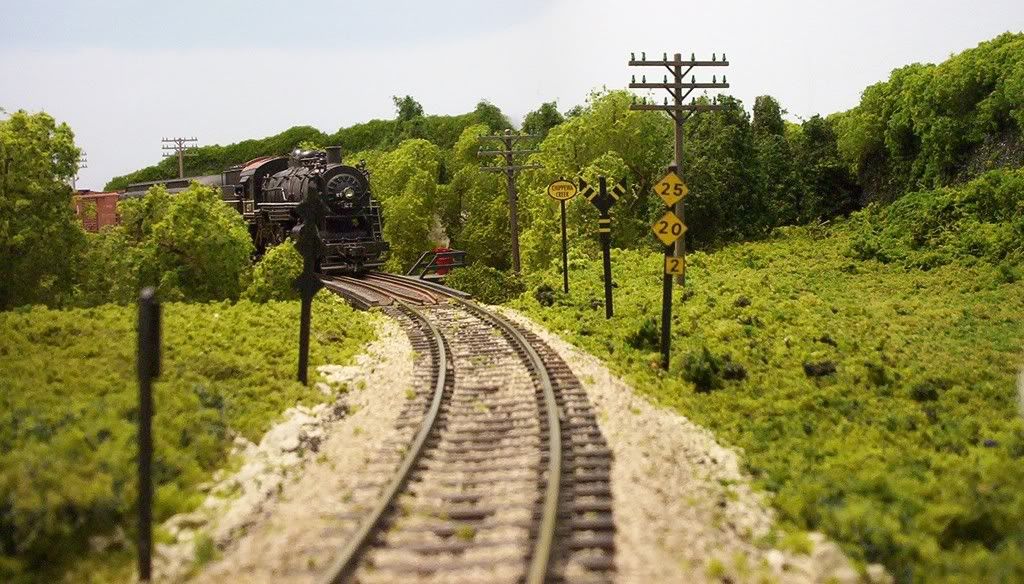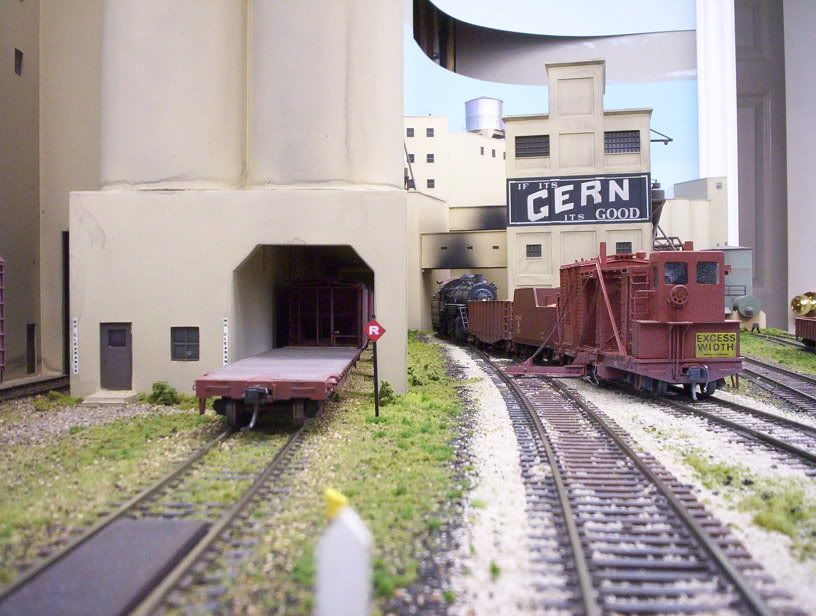Where can I find the correct placement for rail side signs such a whistle, siding, derail, etc.
Thanks JIM
Where can I find the correct placement for rail side signs such a whistle, siding, derail, etc.
Thanks JIM
Hi and welcome to the forum. Derail signs are right by the derail . Whistle posts are set a predetermined way away from grade crossings ( depending on speed of the rail line) Now what do you mean by siding signs?
If you have any more questions feel free to ask.
That brings up something I’ve been wondering since I’ve got two locations that I’ve been wondering about on my layout… How are whistle posts situated for a multiple-track line? With a double-track line, I’ve seen them placed on both sides of the right of way, but what about for three or more tracks? If there are whistle posts on either side of a 3-track route and the outside tracks are occupied (blocking view of the whistle posts), how would a crew on the middle track know about the whistle posts?
Kevin
Ask a real railroad, here are the UP’s specs for industrial track development. In there are diagrams for clearances buildings and signs.
http://www.uprr.com/aboutup/operations/specs/track/index.shtml
The engineman and conductor had to be qualified on the physical characteristics of the portion of the railroad they were operating over. They had to know the location of all signals, switches, crossings, yard limits, etc. If the whistle post was not visible or missing (pretty common on some eastern roads in the 1960s and 1970s) they were still responsible for sounding the whistle at the proper location. A signal that was missing or defective had to be taken as the most restrictive indication that signal could display.
Dave,
Thanks for the UP info–most interesting to explore–wish there was even more.
Ed
signage and placement are now strictly regulated by the FRA. If you are modeling pre 60’s railroads, then the placement and use of signs was, in a large part, unregulated. Here are some generics, without bias, so put the flamethrowers away gang:
Siding: generally placed one mile from the switch that a train would use to clear the main track.
Whistle: generally placed one fourth of a mile in advance of a grade crossing, tunnel or bridge.
Advance Yaed Limit Sign: generally placed one mile in advance of yard limits
Yard Limit Sign: placed at the start of yard limits
Water: placed one mile or more in advance of a water tank or other watering facility
Junction: Generally placed one mile in advance of a junction
Summit: Generally placed at the apex or summit of a grade
Station Sign: if in timetable and train order territory, it would be placed at the point where time applied
Close Clearance: placed sufficiently in advance of a close clearance, i.e., where a person riding on the side of a car could be struck by a sstructure close to the tracks, to allow a train to stop or an employee to get off the equipment safely.
Stop Sign: placed at a grade crossing that is not protected by gates or other devices, usually not on a main track; required trains to stop prior to entering the crossing.
These are but a few of the many signs railroads used. They would generally be placed to the right of the track affected in the direction of approach, if clearance permitted. On the CNW and a couple of other roads where trains ran “left-handed” in double track, the signs would be to the left of a train in direction of approach. In multiple main track territory, one mig
Actually the signage requirements are set by the individual railroads and the FRA audits the compliance of the railroad with its own rules. As you mention, these are generic signs, some railroads don’t use all of them.
The station sign would be placed at the station. If there was no siding, time would apply at the station, if there was a siding, time would apply at the switch where an opposing switch would clear. So that would be the west switch for an eastward trains and the east switch for a westward train.
Other types of signs are speed restriction signs and resume speed signs, plus mileposts.
Trackside signs can not only add detail to your scenes, but also improve your operations. However, because of limited space, we’re often forced to condense those prototype distances noted above.
In the scene below, the 25/20 sign is a speed limit (25mph for passenger trains, 20mph for freights). The “2” on the same post indicates that the limit is in force until the next speed sign topped by an “RS” indicating “Resume Speed”.

Beyond the speed limit sign is a plow/flanger warning sign - the chevron shape (which could include both sides, only the left, only the right, or neither), signals a plow operator to retract the plow wing on the side indicated, while the vertical board indicates that the flanger blade must be lifted. All of these signs have at least one yellow stripe (for visibility) and, like the ones here, many have two stripes indicating that the obstacle(s) are multiple. Signs with double stripes will be followed by a “C” sign, indicating “CLEAR” after all obstacles in the sequence have been passed.

Here’s the same area as the first photo, with a “RESUME SPEED” at the top of the speed limit signs:

This “R” indicates a restriction as outlined in the Rulebook: in this case, it’s low overhead clearance, requiring all locos to use idler cars, as required, to switch this siding, and also prohibiting excess height cars from the siding.

I also use the “R” to prohibit plows, spreaders, and weed sprayers from station platform tracks, due to restricted side clearance.
Here’s a whistle post:
WOW Wayne what an awesome layout! Now can you tell me what is in front of that steam engine in the resume speed picture?I love the pics and wonder if we can see more!
Thank you for the very kind words, route rock. [:)]
While I’m only too pleased to post photos of my layout, I don’t want to side-track this thread. A quick search, especially in the General Discussion Forum should yield some links to more pictures, and, if you’d like to see more, here’s a link to a Layout (room) tour, with lots of photos… and another, entitled Barney Secord flies the Grand Valley…, which is basically a trackplan done in the form of a fly-over of the layout.
EDIT: Oops! [banghead] I’m sorry, but I forgot that the pictures in the links are viewable only by Members of that Forum. It’s free to join, if you’d care to look, but otherwise, try the “Search” function here.
As for the steam loco with the debris on the track, it’s one of the climactic photos in a short story thread which I posted on another forum - I believe that the story may still be there, but the photos, alas, have been removed.
Here’s what was in front of the loco a few seconds before the photo above was taken (actually, I can’t find the original picture, but this is the same vehicle at the same crossing, but headed in the opposite direction):

Two brothers, taking a load of chickens to market, were trying to move their disabled vehicle from the crossing when the accident occurred. With the loco pushing its tonnage rating for the division (and a very green fireman too busy trying to maintain his fire to have time to watch ahead from the lefthan
I’ll give you the frirst one, but you’ll have to explain the second one, or at least your wording of it.
Quoting the Southern Pacific Rulebook from 1969:
Under definitions: Station…A place designated in the timetable by name.
Your response seemed to imply that a station had to be a structure, rather than a location. It does not. If this was not your intention, accept my apologies now.
Continuing on: Paragraph 2 of Rule 5: “Unless otherwise provided, time applies at the clearance point of a siding where an inferior train must be clear of the main track; where there is no siding it applies at the train order signal; where there is neither siding nor train order signal, it applies at the station sign.”
Please note that the above referenced rule does not state “station” “station building” or anything else, so my comment earlier was in fact correct, provided neither of the first two conditions existed. Since a station is a location rather than a building or structure, time would in fact apply at the station sign.